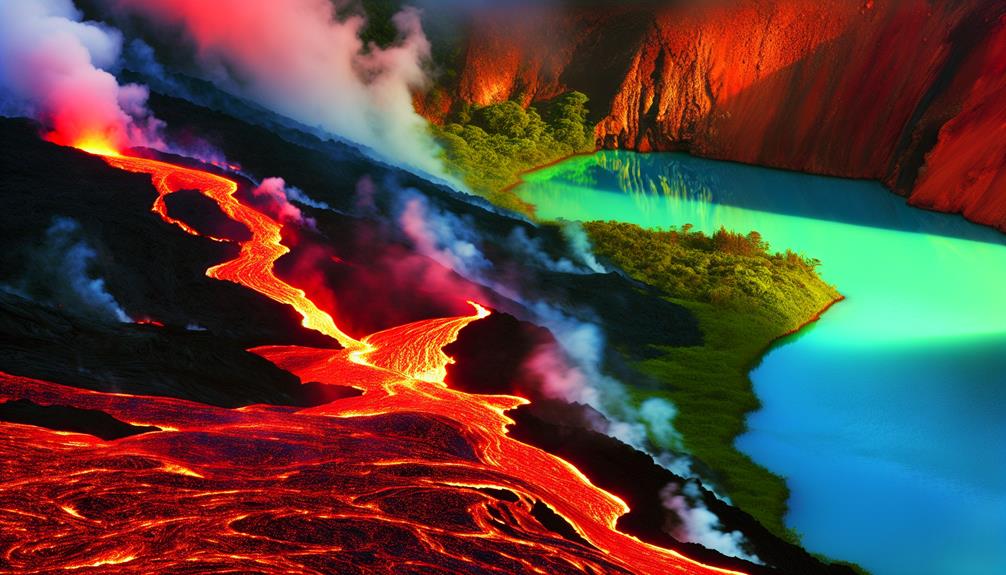Maneuvering the fiery landscapes of lava and the dynamic aqua environments demands a thorough approach. Understanding the geological formations of lava, including flow patterns and ecological recovery, is critical for safety and appreciation. Similarly, mastery of water chemistry and aquatic ecosystems is essential in preventing hazards such as algal blooms. Key gear—ranging from heat-resistant suits for lava terrain to wetsuits for aquatic exploration—ensures safety and preparedness. Recognizing hidden dangers like strong currents or volcanic activities further enhances maneuvering. With these considerations in mind, adventurers can efficiently traverse these extreme environments and uncover further insights into their intricate ecosystems.
Key Takeaways
- Equip yourself with specialized gear, such as heat-resistant gloves for lava and wetsuits for aquatic environments, to ensure safety and comfort.
- Understand the terrain by studying lava flow patterns and aquatic currents to identify safe navigation routes.
- Monitor temperature changes in lava areas using sensors to detect volcanic activity and ensure ground stability.
- Be aware of hidden dangers like submerged rocks and unpredictable currents in aquatic settings to enhance safety.
- Embrace an adventure mindset while prioritizing safety protocols to navigate extreme environments effectively.
Understanding Lava Landscapes

Understanding Lava Landscapes
Lava landscapes, characterized by their striking geological formations and dynamic processes, offer a unique glimpse into the Earth's volcanic activity. These regions, shaped by the flow and cooling of molten rock, reveal a complex interplay of natural forces that define our planet's geology. Regular exploration of these landscapes can also promote physical health, much like the surprising health perks of walking. The various types of lava formations, such as lava tubes, pahoehoe, and aa, provide insights into the conditions under which they were created, influencing not only the physical environment but also the biological communities that emerge in these areas.
Understanding these landscapes is essential for comprehending the broader implications of volcanic activity on ecosystems and human settlements. Lava formations often serve as a canvas for ecological succession, where life gradually re-establishes itself in the wake of volcanic eruptions. This resilience illustrates the interconnectedness of geological and biological processes.
Moreover, studying lava landscapes can enhance our preparedness for future volcanic events. By analyzing the patterns of past eruptions, scientists can better predict potential hazards, fostering a sense of belonging and safety among communities living in proximity to these dynamic environments. Through this understanding, we can appreciate the beauty and power of our planet's volcanic landscapes while promoting informed stewardship of these extraordinary ecosystems.
The Science of Aqua Environments
The intricate balance of aquatic environments reveals the profound interconnectedness of physical, chemical, and biological processes that sustain life in water. Water chemistry plays a significant role in shaping the characteristics of aquatic ecosystems, as variations in pH, salinity, and nutrient concentrations directly influence the health and diversity of these environments. Importantly, the introduction of beneficial substances, such as tart cherry juice's health benefits, can enhance the liveliness of certain aquatic organisms. Understanding the dynamics of water chemistry is essential for preserving the delicate equilibrium within aquatic habitats.
Aquatic ecosystems, ranging from freshwater lakes to expansive oceans, host a myriad of organisms that interact in complex ways. The presence of key nutrients, such as nitrogen and phosphorus, can stimulate primary productivity; however, excessive nutrient loading may lead to harmful algal blooms, disrupting the balance and threatening aquatic life. Additionally, the physical structure of these ecosystems, including currents and substrates, affects organism distribution and community composition.
Sustaining healthy aquatic ecosystems requires a thorough understanding of these interrelated processes. By appreciating the foundations of water chemistry and its impact on biological communities, individuals and communities can foster a greater sense of stewardship, ensuring the longevity and liveliness of our precious aquatic environments for generations to come.
Essential Gear for Exploration

An array of essential gear is critical for successful exploration of both fiery and watery worlds, as it guarantees safety, efficiency, and a deeper understanding of these unique environments. The right equipment not only enhances the exploration experience but also assures that adventurers are prepared for the challenges posed by extreme conditions.
| Gear Type | Description |
|---|---|
| Lava Tools | Protective gear, heat-resistant gloves, and specialized rock hammers for traversing volcanic terrains. |
| Aquatic Equipment | High-quality wetsuits, buoyancy aids, and underwater cameras for safe and effective exploration of aquatic ecosystems. |
| Navigation Devices | GPS units and compasses tailored for harsh environments, guaranteeing accurate positioning. |
| First Aid Kits | All-encompassing kits stocked with supplies for both thermal and aquatic injuries, assuring preparedness for emergencies. |
Investing in quality lava tools and aquatic equipment is essential for any serious explorer. By equipping oneself with the right gear, one not only enhances personal safety but also promotes a sense of belonging within a community of like-minded adventurers who respect and cherish the wonders of our planet's fiery and watery domains.
Safety Tips for Lava Terrain
Maneuvering lava terrain presents unique hazards that require careful preparation and awareness. Just as individuals face challenges in their environments, such as Sarah Silverman's experiences with mental health struggles, it is essential to wear protective gear, identify safe paths, and continuously monitor temperature changes to mitigate risks associated with extreme heat and unstable ground. Implementing these safety measures can greatly enhance the safety and effectiveness of exploration in such volatile environments.
Wear Protective Gear
Venturing into lava terrain necessitates the use of appropriate protective gear to guarantee safety in this hazardous environment. The extreme temperatures, sharp volcanic rocks, and potential toxic gases demand the highest level of caution and preparedness. Proper protective clothing includes heat-resistant suits, which provide insulation and shield against burns. In addition, sturdy, thick-soled boots are essential to protect feet from both the rough terrain and the intense heat radiating from the ground.
Safety equipment should not be overlooked. Helmets equipped with face shields can safeguard against falling debris and reduce the risk of injury from sharp objects. Moreover, gloves made from heat-resistant materials are vital to prevent burns during interactions with the environment. It is also advisable to carry a first aid kit specifically designed for volcanic environments, ensuring immediate access to essential medical supplies in case of an emergency.
Participants in these adventurous pursuits must prioritize their safety by investing in high-quality protective gear. By doing so, they not only enhance their personal safety but also foster a culture of responsible exploration, ensuring that others in the group feel secure and supported in their shared experience.
Identify Safe Paths
Safe path identification in lava terrain is critical for minimizing risks associated with unstable ground and hazardous conditions. Understanding lava flow patterns is essential to discern the safest routes. These patterns reveal the trajectory and cooling rates of lava, informing hikers of potentially dangerous zones. Familiarity with previous eruptions can provide insight into current terrain stability.
When traversing lava fields, prioritize areas where the ground appears solidified and free from cracks or gas emissions. Additionally, look for natural barriers or features that indicate safer terrain, avoiding steep slopes or unstable ledges. It is also prudent to be aware of aquatic terrain features, as these can present unique challenges, particularly in regions where lava meets water. The interaction between lava and water can create steam explosions, making proximity to these areas risky.
Utilizing maps and satellite imagery can enhance your understanding of the landscape, allowing for informed decision-making regarding route selection. Always remain vigilant and prepared for sudden changes in conditions, as the environment can be unpredictable. By adhering to these guidelines, adventurers can traverse lava terrain with greater confidence, fostering a sense of belonging within the community of explorers.
Monitor Temperature Changes
Temperature changes in lava terrain can serve as significant indicators of volcanic activity and ground stability. Monitoring these fluctuations is essential for ensuring safety in such hazardous environments. Utilizing temperature sensors strategically placed across the terrain can provide real-time data, alerting observers to any significant variations that may signal impending eruptions or lava flow movement.
In addition to traditional methods, thermal imaging technology enhances our ability to visualize temperature differences across vast areas. This non-invasive technique allows for thorough assessments of hot spots that may not be immediately visible to the naked eye. By integrating thermal imaging with temperature sensor data, researchers and explorers can develop a more nuanced understanding of the landscape's behavior.
Adopting a proactive approach to monitoring these temperature changes fosters a sense of belonging among those engaged in volcanic studies or rescue operations. It emphasizes a collective responsibility to prioritize safety in potentially volatile conditions. By remaining vigilant and informed, we not only protect ourselves but also contribute to the broader community's knowledge of lava terrain dynamics. This commitment to safety and awareness is essential for anyone traversing these fiery domains.
Navigating Ocean Challenges

Maneuvering ocean challenges requires an all-encompassing understanding of strong currents and the potential hazards they present. Just as innovative fitness techniques like backward treadmill workouts can enhance physical performance, awareness in aquatic environments can greatly improve safety. Effective strategies must be employed to recognize hidden dangers, such as submerged rocks and unpredictable marine life, which can pose considerable risks to both novice and experienced navigators. By prioritizing awareness and preparation, individuals can enhance their safety and efficacy in these dynamic aquatic environments.
Overcoming Strong Currents
Facing the relentless power of strong ocean currents presents a formidable challenge for seafarers and adventurers alike. Effective current navigation is vital to guarantee aquatic safety and maintain a secure passage through unpredictable waters. Understanding river dynamics and the factors influencing current strength is significant in minimizing the risks associated with swift currents.
Navigators must consider the impact of water resistance as they traverse these challenging environments. Eddy formations, which can occur in the interface between swift currents and slower waters, can either assist or impede progress, depending on their positioning. Knowledge of these formations allows adventurers to harness the energy of the water rather than fight against it.
Moreover, underwater currents often operate below the surface, creating hidden challenges that require vigilance and skill. To overcome these obstacles, seafarers should utilize advanced equipment and techniques to enhance their awareness of changing conditions. Training in current navigation not only builds confidence but also fosters a sense of community among those who brave the ocean's depths. By cultivating an all-encompassing understanding of these factors, adventurers can navigate strong currents with both precision and safety, guaranteeing a more enjoyable and secure experience on the water.
Identifying Hidden Dangers
Often overlooked by inexperienced adventurers, hidden dangers in ocean environments can greatly compromise safety and navigation. These aquatic threats manifest in various forms, from unpredictable currents to submerged rocks, all of which can pose significant risks to even the most seasoned navigators. Understanding these dangers is vital for ensuring a safe journey through oceanic domains.
One prevalent concern is the proximity of lava hazards, particularly in areas near volcanic islands. These regions may have unpredictable underwater volcanic activity, leading to sudden changes in water temperature and unpredictable gas emissions. Awareness of these geological phenomena is essential for avoiding potential catastrophes.
Additionally, marine life can also present challenges, including dangerous species such as jellyfish and sharks, which may not always be visible. Navigators must be equipped with the knowledge to identify and avoid these aquatic threats, ensuring their safety and that of their crew.
Wildlife in Fiery and Watery Worlds
Diverse ecosystems thrive in both fiery and watery domains, showcasing a remarkable array of wildlife adapted to extreme environments. In volcanic landscapes, lava fauna exhibits exceptional thermal adaptations, enabling survival amid scorching temperatures. Species such as the resilient extremophiles and specific insects demonstrate unique survival strategies, contributing to significant volcanic biodiversity. Additionally, organisms in these harsh conditions often rely on high-fat diets to sustain their energy levels, akin to the principles of a Ketovore diet, which emphasizes low-carb, high-fat nutrition.
In contrast, aquatic species flourish in underwater ecosystems, exhibiting various forms of adaptation to their dynamic habitats. Marine life, from coral reefs to deep-sea organisms, showcases habitat resilience and intricate ecological interactions that sustain these vibrant environments. The migration of species, driven by environmental changes, highlights the interconnectedness of these ecosystems, illustrating the delicate balance between aquatic and terrestrial life.
These adaptations and interactions not only enhance the survival chances of each species but also foster a sense of belonging within their respective ecosystems. Understanding wildlife in these fiery and watery domains emphasizes the importance of conservation efforts, as these unique organisms face threats from climate change and habitat destruction. Their survival is vital for maintaining the ecological integrity of both volcanic and aquatic environments, ensuring a rich tapestry of life continues to thrive.
Embracing the Adventure

Embracing the adventure of exploring fiery and watery worlds involves a profound understanding of the unique challenges and rewards presented by these extreme environments. Adopting an adventure mindset allows individuals to navigate these terrains with both caution and enthusiasm. The thrill-seeking spirit within us drives the desire to push boundaries and discover the unknown, leading to unforgettable experiences.
Engaging with these environments comes with risks, yet the rewards often far outweigh them. The following table outlines key considerations for adventurers delving into these domains:
| Environment | Key Considerations |
|---|---|
| Fiery Worlds | Temperature management, protective gear, navigation skills |
| Watery Worlds | Underwater visibility, buoyancy control, safety protocols |
| Common Hazards | Lava flows, sudden waves, wildlife encounters |
| Essential Gear | Heat-resistant clothing, life jackets, communication devices |
Frequently Asked Questions
What Are the Best Times of Year for Lava Exploration?
The best times for lava exploration typically align with the dry season, which often occurs in summer or late winter, depending on the region. Key locations include Hawaii's Kilauea and Iceland's Fagradalsfjall, where volcanic activity is both frequent and accessible. Prioritizing safety precautions, such as wearing appropriate gear and adhering to local guidelines, is essential to guarantee a secure experience while observing these remarkable geological phenomena. Proper planning enhances both safety and enjoyment during exploration.
How Do Weather Conditions Affect Lava and Aqua Navigation?
Weather patterns considerably influence navigation in volcanic and aquatic environments, presenting unique navigation challenges. In volcanic areas, heavy rainfall can induce mudflows, obscuring paths and increasing hazards. Conversely, extreme heat may cause hazardous gas emissions. In aquatic settings, turbulent weather can create rough seas, complicating navigation and safety. Understanding these weather dynamics is essential for effective exploration and guarantees that individuals can navigate these diverse terrains with confidence and competence, fostering a sense of community among explorers.
Can I Explore Lava and Aqua Sites Solo?
Exploring lava and aqua sites solo is certainly feasible; however, it necessitates meticulous planning and adherence to safety precautions. Solo exploration can enhance personal connection to the environment, yet it also amplifies risks, such as unpredictable conditions and lack of immediate assistance. Prior to starting on such an adventure, individuals should assess their experience level, familiarize themselves with the terrain, and guarantee proper safety gear is utilized, thereby fostering a secure and enriching exploration experience.
Are There Any Cultural Considerations in These Environments?
Exploring environments characterized by extreme elements necessitates an awareness of cultural considerations. Many regions associated with lava and water feature cultural rituals that are deeply rooted in indigenous beliefs. These practices often reflect the community's relationship with nature, emphasizing respect and reverence for the land. Engaging with these cultures requires sensitivity and understanding, as visitors must navigate the significance of these rituals to foster a sense of belonging and mutual respect with local communities.
What Fitness Level Is Required for Exploration in These Terrains?
Exploring challenging terrains necessitates a specific level of fitness preparation to effectively navigate the diverse terrain challenges encountered. Individuals should focus on cardiovascular endurance, strength training, and flexibility to enhance their physical capabilities. A solid fitness foundation mitigates the risks associated with extreme environments, facilitating smoother navigation and reducing injury potential. Ultimately, achieving an adequate fitness level not only promotes safety but also fosters a sense of belonging within communities engaged in exploration activities.




